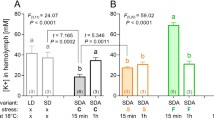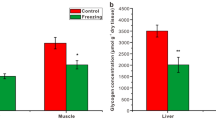Summary
Freeze-tolerance in larvae ofGynaephora groenlandica is enhanced by the accumulation of glycerol in the winter. Since summer larvae remain freeze-tolerant despite the lack of glycerol, we investigated glycerol metabolism as a function of acclimation and body temperature using non-invasive13C NMR spectroscopy. Major constituents of hemolymph isolated from cold- and warm-acclimated larvae were identified with the aid of standard NMR spectra and confirmed by TLC and GLC. Spectra obtained on live, warm-acclimated larvae showed the presence of lipids, glycogen, glucose, trehalose and amino acids. Similar spectra of cold-acclimated or previously frozen larvae showed the additional presence of glycerol. In vitro time-lapse13C spectra ofd-[1-13C]glucose added separately to hemolymph or extracted fat body tissue showed that glycerol is synthesized from glucose in the fat body tissue and distributed to the peripheral tissue via hemolymph. In vivo time-lapse13C spectra of cold- and warm-acclimated larvae were obtained after injection withd-[1-13C]glucose to monitor the production of labeled metabolic intermediates and end-products. [13C]Glycerol was produced between −30°C and 30°C but accumulated only below 5°C. Above 5°C glycerol was degraded and the13C label incorporated mainly into glycogen. The mechanism underlying temperature control of glycerol biosynthesis and degradation may provide a clue to the role of glycerol in enhancing freeze-tolerance in these insects.
Similar content being viewed by others
References
Baust JG, Rojas RR (1984) Review — insect cold-hardiness: facts and fancy. J Insect Physiol 31:755–759
Bock K, Pedersen C (1983) Carbon-13 nuclear magnetic resonance spectroscopy of monosaccharides. Adv Carbohydr Chem Biochem 41:27–66
Buchanan GW, Storey KB (1983) In vivo detection of cryoprotectants and lipids in overwintering larvae using carbon-13 NMR spectroscopy. Can J Cell Biol 61:1260–1264
Chen C, Denlinger DL, Lee RE (1987) Cold-shock and rapid cold-hardening in the flesh flySarcophaga crassipalpis. Physiol Zool 60:297–304
Crowe JH, Crowe LM (1982) Induction of anhydrobiosis: membrane changes during drying. Cryobiology 19:317–328
Danks HV (1978) Modes of seasonal adaptations in insects: I. Winter survival. Can Entomol 110:1168–1205
Duman JG (1984) Change in the overwintering mechanism of the cucujid beetle,Cucujus clavipes. J Insect Physiol 30:235–239
Mayakawa Y, Chino H (1982) Phosphofructokinase as a possible key enzyme regulating glycerol or trehalose accumulation in diapansing insects. Insect Biochem 12:639–692
Hayes ML, Pennings NJ, Serianni AS, Barker R (1982) Epimerization of aldoses by molybdate involving a novel rearrangement of the carbon skeleton. J Am Chem Soc 104:6764–6769
Kukal O, Kevan PG (1987) The influence of parasitism on the life history of a high arctic insect,Gynaephora groenlandica (Wöcke) (Lepidoptera: Lymantriidae). Can J Zool 65:156–163
Kukal O, Dawson TE (submitted) Temperature and food quality influences on feeding behavior, assimilation efficiency and growth rate in arctic woolly-bear caterpillars. Oecologia
Kukal O, Heinrich B, Duman JG (in press) Behavioral thermoregulation in the freeze-tolerant arctic caterpillar,Gynaephora groenlandica. J Exp Biol
Miller LK (1982) Cold-hardiness strategies of some adult and immature insects overwintering in interior Alaska. Comp Biochem Physiol [A] 73:595–604
Neven LG, Duman JG, Beals JM, Castellino FJ (1986) Overwintering adaptations of the stag beetle,Ceruchus piceus: removal of ice nucleators in the water to promote supercooling. J Comp Physiol B 156:707–716
Nordin JH, Cui Z, Yin C (1984) Cold-induced glycerol accumulation byOstrinia nubilalis larvae is developmentally regulated. J Insect Physiol 30:563–566
Ramsay JA (1964) The rectal complex of the mealwormTenebrio molitor L. (Coleoptera: Tenebrionidae). Phil Trans R Soc [B] 248:279–314
Rojas RR, Lee RE, Luu T-A, Baust JG (1983) Temperature dependence-independence of antifreeze turnover inEurosta solidaginis (Fitch). J Insect Physiol 29:865–869
Salt RW (1961) Principles of insect cold-hardiness. Annu Rev Ent 6:55–74
Salt RW (1966a) Effect of cooling rate on the freezing temperature of supercooled insects. Can J Zool 44:655–659
Salt RW (1966b) Factors influencing nucleation in supercooled insects. Can J Zool 44:117–133
Schaefer J, Kramer KJ, Garbow JR, Jacob GS, Stejskal EO, Hopkins TL, Speirs RD (1987) Aromatic cross-links in insect cuticle: detection by solid-state13C and15N NMR. Science 235:1200–1204
Serianni AS, Nunez HA, Barker R (1979) Carbon-13-enriched carbohydrates. Preparation of aldononitriles and their reduction with a palladium catalyst. Carbohydr Res 72:71–78
Sømme L (1964) Effects of glycerol on cold-hardiness in insects. Can J Zool 43:765–770
Sømme L (1974) Anaerobiosis in some alpine Coleoptera. Nor Entomol Tidsskr 21:155–158
Sømme L (1982) Supercooling and winter survival in terrestrial arthropods. Comp Biochem Physiol [A] 73:519–543
Storey KB (1983) Metabolism and bound water in overwintering insects. Cryobiology 20:365–379
Storey KB, Miceli M, Butler KW, Smith ICP, Deslauriers R (1984)31P NMR studies of the freezing-tolerant larvae of the gall fly,Eurosta solidaginis. Eur J Biochem 152:591–595
Tauber MJ, Tauber CA, Musaki S (1986) Seasonal adaptations of insects. Oxford University Press, New York
Tsumuki H, Kanehisa K (1981) The fate of14C-glycerol in the rice stem borer,Chilo suppressalis Walker (Lepidoptera: Pyralidae). Appl Entomol Zool 16:200–208
Tsumuki H, Rojas RR, Storey KB, Baust JG (1986) The fate of [13C]glucose during cold-hardening inEurosta solidaginis (Fitch) Insect Biochem 17:347–352
Yancey PH, Clark ME, Hank SC, Bowlus RD, Somero GN (1982) Living with water stress: evolution of osmolyte systems. Science 217:1214–1222
Yi S, Yin C, Nordin JH (1987) The chilling-induced biosynthesis and secretion of glycerol byOstrinia nubilalis larval fat bodies in vitro. J Insect Physiol 33:523–528
Zachariassen KE (1979) The mechanism of the cryoprotective effect of glycerol in beetles tolerant to freezing. J Insect Physiol 25:29–32
Zachariassen KE (1982) Nucleating agents in cold-hard insects. Comp Biochem Physiol [A] 73:557–562
Zachariassen KE (1985) Physiology of cold tolerance in insects. Phys Rev 65:799–832
Zachariassen KE, Baust JG, Lee RE Jr (1982) A method for quantitative determination of ice nucleating agents in insect hemolymph. Cryobiol 19:180–184
Ziegler R, Roth K (1985)13C NMR spectroscopy of larvae ofManduca sexta in vitro. Nature 72:206–207
Author information
Authors and Affiliations
Rights and permissions
About this article
Cite this article
Kukal, O., Serianni, A.S. & Duman, J.G. Glycerol metabolism in a freeze-tolerant arctic insect: an in vivo13C NMR study. J Comp Physiol B 158, 175–183 (1988). https://doi.org/10.1007/BF01075831
Accepted:
Issue Date:
DOI: https://doi.org/10.1007/BF01075831




